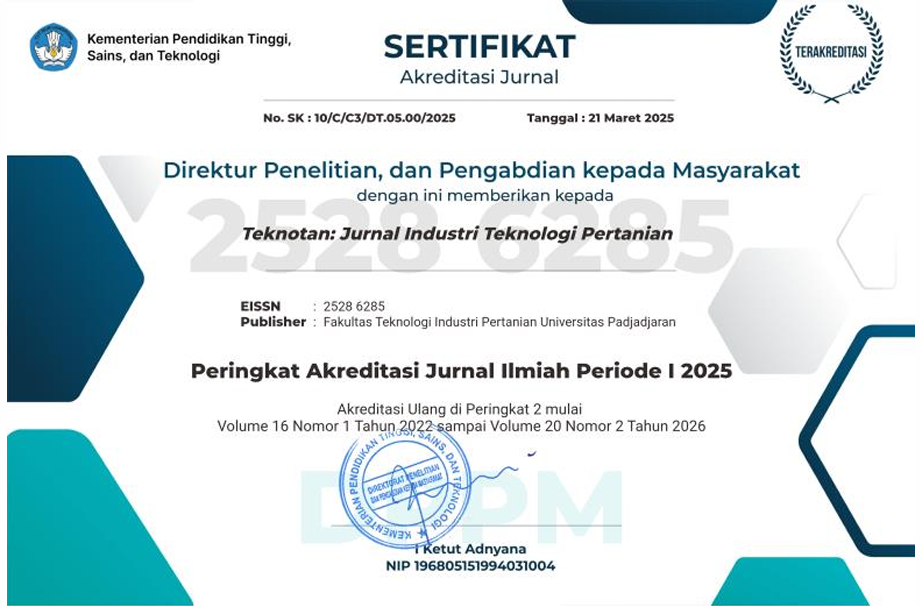Prediction Model of Basal Stem Rot (BSR) Based on Ganoderma Boninense Using UV/Vis Diffuse Reflectance Spectroscopy
Abstract
Basal Stem Rot (BSR) disease was considered as the most destructive disease in oil palm tree. Ganoderma boninense. fungi causing BSR on oil palm tree, could release cell wall degrading enzymes (CWDE) which responsible to degrade polysaccharide on oil palm tree cell wall such as cellulose and lignin into reducing sugar. In this research optical measurement using UV/Vis Diffuse Reflectance Spectroscopy (DRS) was utilized to qualify and quantify BSR level based on its reducing sugar. Several stages were conducted to qualify and quantify reducing sugar comprising sample preparation, spectral data acquisition and chemometrics analysis. Health Stem (HS) and Infected Stem (IS) were prepared. The two stem condition were dried and powdered separately then mixed into 5 mixtures from both stems (100% HS, 75% HS + 25% IS + 50% HS + 50% IS, 25% HS +75% IS and 100% IS) and duplicated to produce 10 total sample. Reducing sugar was measured for each sample. Other than that, spectrum acquisition data was conducted using UV/Vis DRS. In the final stage, chemometrics analysis was performed where reducing sugar was set as response and spectral data was set as predictor. The result showed that Principal Component Analysis (PCA) could well classify 4 group of mixtures. While for quantitative analysis, Partial Least Square (PLS) and Support Vector Machine Regresion (SVR) were used to develop prediction model of reducing sugar. PLS showed low performance with the highest R2 val and R2 cal accounting for 0.218 and 0.019 and RMSEC and RMSECV were 0.019 and 0.023, respectively. Besides, SVMR using first derivative savitzky-golay (DG1) preprocessing showed high R2 cal and R2 val accounting for 0.823 and 0.701 with RMSEC and RMSECV were 0.012 and 0.028, respectively.
Keywords
Full Text:
PDFReferences
Beattie, J. R., & White, F. W. L. E. (2021). Exploration of Principal Component Analysis: Deriving Principal Component Analysis Visually Using Spectra. Applied Spectroscopy. Vol.75, No.4: 361-375.
Chanda, S., Hazarika, A. K., Choudhury, N., Islam, S. A., Manna, R., Sabhapondit, S., Tudu, B., Bandyopadhyay, R. (2019). Support vector machine regression on selected wavelength regions for quantitative analysis of caffeine in tea leaves by near infrared spectroscopy. Journal of Chemometrics. Vol.33 No.10:1-15.
Chong, K.P., Dayou, J., Alexander, A. (2017). Detection and Control of Ganoderma boninense in Oil Palm Crop. Springer Briefs in Agriculture (Chapter 2): 5-12.
Flint, T. H., & Boudreaux, E. A. (1982). Quantitative UV-Visible Diffuse Reflectance Spectroscopy of Solid Powder. Spectroscopy Letter. Vol.15, No.5: 383-397.
Food and Agriculture Organization (FAO). 2020. Oil Palm Fruit. http://data.un.org/Data.aspx?d=FAO&f=itemCode%3A254.
Francis, M. M., Jonathan P. Blitz. (1998). Modern Techniques in Applied Molecular Spectroscopy. Wiley.
Hashim, I. C., Shariff, A. R. M., Bejo, S. K., Muharam, F. M., & Ahmad, K. (2021). Machine-Learning Approach Using SAR Data for the Classification of Oil Palm Trees That Are Non-Infected and Infected with the Basal Stem Rot Disease. Agronomy. Vol.11 No.3: 1-17.
Helland, I. S. (2001). Some theoretical aspects of partial least squares regression. Chemometrics and Intelligent Laboratory Systems. Vol.58 No.1: 97-107.
Husin, N. A., Khairunniza-Bejo, S., Abdullah, A. F., Kassim, M. S. M., Ahmad, D., & Aziz, M. H. A. (2020). Classification of basal stem rot disease in oil palm plantations using terrestrial laser scanning data and machine learning. Agronomy. Vol.10 No.11: 1-23.
Kamu, A., Phin, C.K., Seman, I.A., Mun, H.C. (2015). Distribution of infected oil palms with Ganoderma basal stems root disease. Journal of Scientific Research and Development. Vol.2 No.10: 49-55.
Kresnawaty, I., Mulyatni, A. S., Eris, D. D., Prakoso, H. T., Tri-Panji, Triyana, K., & Widiastuti, H. (2020). Electronic nose for early detection of basal stem rot caused by Ganoderma in oil palm. IOP Conference Series: Earth and Environmental Science. 468(1).
Lisnawita, Hanum, H., and Tantawi, A.R. (2016). Survey of Basal Stem Rot Disease on Oil Palms (Elaeis guineensis Jacq.) in Kebun Bukit Kijang,North Sumatera, Indonesia. IOP Conference Series: Earth and Environmental Science, 41(1):1-6.
Lund, M. N., Ray, C. A. (2017). Control of Maillard Reactions in Foods: Strategies and Chemical Mechanisms. J. Agric. Food Chem. Vol.65: 4537-4552.
Miller G. L. (1959). Use of Dinitrosalicylic Acid Reagent for Determination of Reducing Sugar. Anal. Chem. Vol.31 No.3: 426-428
Myrick, M. L., Brooke, H., Simcock, M. N., Baranowski, M., Morgan, S. L., McCutcheo, J. N. (2011). The Kubelka-Munk Diffuse Reflectance Formula Revisited. Applied Spectroscopy Reviews Vol.46 No.1:140-165.
Rees, R.W. (2006). Ganoderma Stem Rot of Oil Palm (Elaeis Guineensis): Mode of Infection, Epidemiology and Biological Control. PhD Thesis.
Rinnan, Å., Frans, V.D.B., Engelsen, S.B. (2009). Review of The Most Common Pre-Processing Techniques for Near-Infrared Spectra. Trends in Analytical Chemistry. Vol.28 No.10: 1201-1222.
Santoso, H., Tani, H., Wang, X., Prasetyo, A.E., & Sonobe, R. (2019). Classifying the severity of basal stem rot disease in oil palm plantations using WorldView-3 imagery and machine learning algorithms. International Journal of Remote Sensing, Vol.40 No.19: 7624-7646.
Siddiqui, Y., Surendran, A., Paterson, R.R.M., Ali A., & Ahmad, K. (2021). Current strategies and perspectives in detection and control of basal stem rot of oil palm. Saudi Journal of Biological Sciences. Vol 28 No.5:2840-2849.
Silva, P.A.B.D., Souza, G.C.S.D., Paim, A.P.S., Lavorante, A.F. (2018). Spectrophotometric Determination of Reducing Sugar in Wines Employing In-Line Dialysis And A Multicommuted Flow Analysis Approach. J. Chil. Chem. Soc. Vol. 63. No.2:3994-4000.
Statista. (2021). Palm oil consumption worldwide from 2015/2016 to 2020/2021. Statista. https://www.statista.com/statistics/274127/world-palm-oil-usage-distribution/.
Wang, X., Cheng, S., Li, Z., Men, Yu., Wu, J. (2020). Impacts of Cellulase and Amylase on Enzymatic Hydrolysis and Methane Production in The Anaerobic Digestion of Corn Straw. Sustainability. Vol. 12 No.5453: 1–11.
Yen, L.K. & Ali N.S. (2021). Championing Sustainable Treatment of Oil Palm Basal Stem Rot Disease Via Biological Control Agents. Journal of Oil Palm Research.
Yu, G., & Chong, K. (2018). Selected Biomarkers from Oil Palm-Ganoderma Infected Tissues for Detection of Basal Stem Rot Disease. WMSU Reseacrh Journal, Vol.37 No.1: 1-13.
Z Iqbal, Y Wibisono, M A Kamal, A N Komariyah, I P Adiyaksa, B D Argo, R Damayanti. (2020). Feasibility study on the use of UV/Vis spectroscopy to measure total phenolic compound and pH in apple (Malus sylvestris L.) cv. Manalagi. IOP Conference Series: Earth and Environmental Science 475 012003.
DOI: https://doi.org/10.24198/jt.vol15n2.1
Refbacks
- There are currently no refbacks.
Indexed by:

This work is licensed under a Creative Commons Attribution 4.0 International License (CC BY-SA 4.0)


1.png)
.png)







